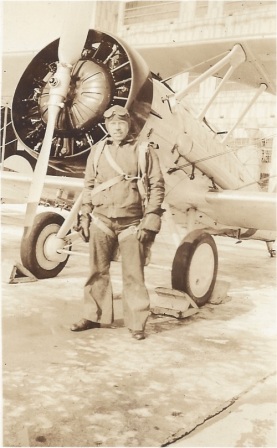
Foil: 19 Panel: 2 Column: 1 Line: 16
Wall of Honor Level: Air and Space Sponsor
Honored by:
Mr. Mike Kunz
Commander Melvin M. Kunz, b.1908-d.1987
In August 1925, a barnstorming pilot in a World War I Jenny landed in a pasture in St. Joseph, Missouri. A wide-eyed farm boy spent his meager 2 bucks for a 15-minute ride. Melvin's first flying experience ignited an undeniable passion that would define his life. By 1928, "that crazy Kunz kid" was flying an open cockpit biplane and barnstorming at Air Shows.
On June 1, 1930, Melvin enlisted in the Navy. Unfortunately the enlisted flight-training program closed so he requested Aviation Mechanics. He was assigned to VO-3B squadron as floatplane mechanic, rear gunner and plane captain aboard the USS Nevada. In May 1937, he reported to Pensacola flight training. Melvin was particularly good at aerial stunt and combat "dog fighting". Graduating in 1938, Kunz was assigned to Squadron VT-6 aboard the USS Enterprise. In 1940, Chief Kunz reported to Pensacola as a flight instructor for Annapolis graduates. A month after Pearl Harbor, newly commissioned Ensign Kunz joined Patrol Squadron 93, flying "Catalina" PBY-5A's patrol bombers hunting German submarines and providing convoy escort in the Atlantic Ocean. He received the Air Medal for flying bombing missions out of Greenland, winter 1942-43. "A fog landing at Greenland BW-1 meant flying 20 ft off the water dodging icebergs."
After the war, LT(jg) Kunz served as a test pilot. He is on the list of the first 100 pilots to fly jet aircraft. "I made many test flights of new jet aircraft and many older aircraft with new equipment installed. In my two years at NAS Patuxent, I flew 29 different types of military aircraft." In 1946, LT. Kunz received instruction for carrier "Landing Signal Officer" and attached to the USS Princeton as LSO where he "signaled aboard 7,000 planes within two years." LT. Kunz also set the record for a single day landing of 72 planes at 28 second intervals.
LtCdr. Kunz reported to the USS Antietam in 1951 as the Aircraft Handling Officer and established procedures to land jets on a carrier. During the Korean War, shot crippled planes crashed into the flight deck. He suggested an "angle deck" to avoid stacked plane damages. After the British Royal Navy made the change, the USS Antietam was so outfitted.
In 1953 Commander Kunz was assigned to the Bureau of Aeronautics Navy Dept., Washington DC. During his three years at Bu-Air he saw his suggested idea of an angle deck refined and implemented. "I assisted in the planning and installation of all aircraft facilities installed in the USS Forrestal, the first super carrier. The 'Mirror Landing' aide program was assigned to me. After many tests and improvements, the 'Landing Mirror System' replaced the L.S.O. on board all U.S. Navy aircraft carriers."
Throughout his life, flight was Commander Kunz's enduring passion. From fabric biplane to the super-sonic jet, his career as pilot, flight instructor, test pilot, LSO, Flight Deck Officer, contributor to the installation of the "Angle Deck" and the "Landing Mirror System" greatly advanced Naval Aviation.
Wall of Honor profiles are provided by the honoree or the donor who added their name to the Wall of Honor. The Museum cannot validate all facts contained in the profiles.
Foil: 19
